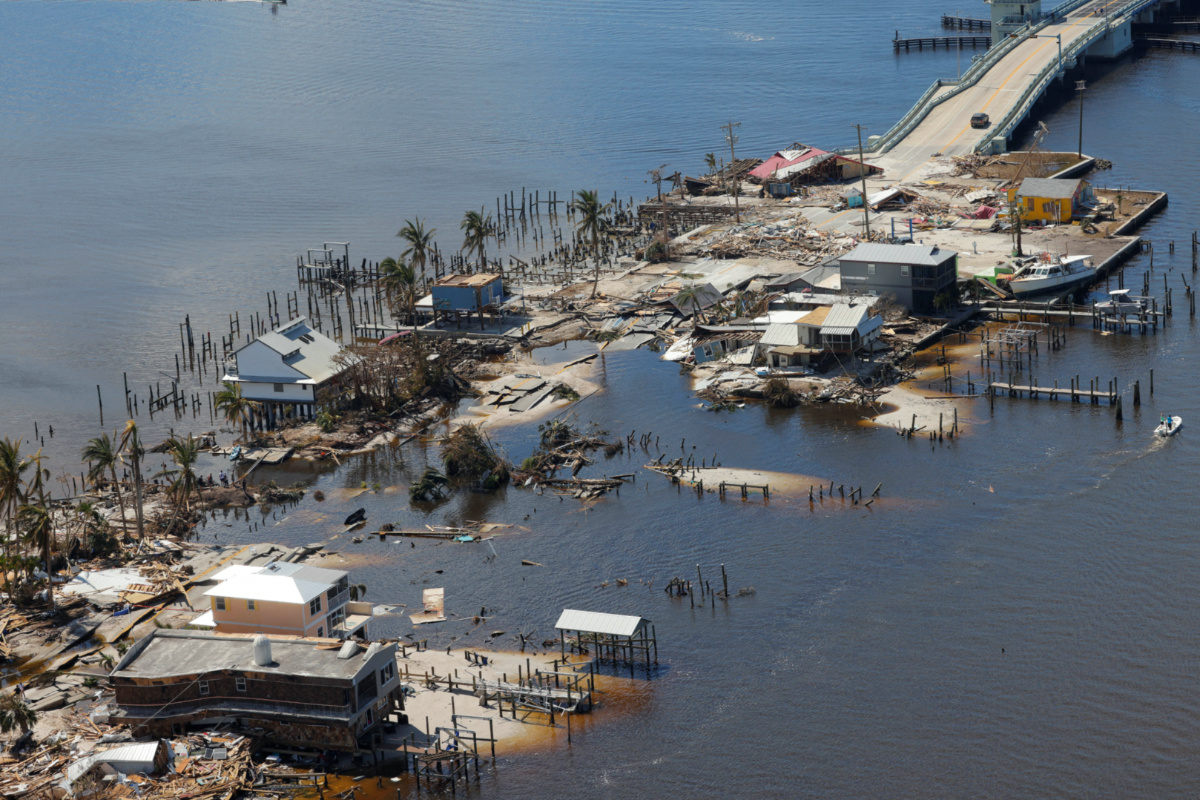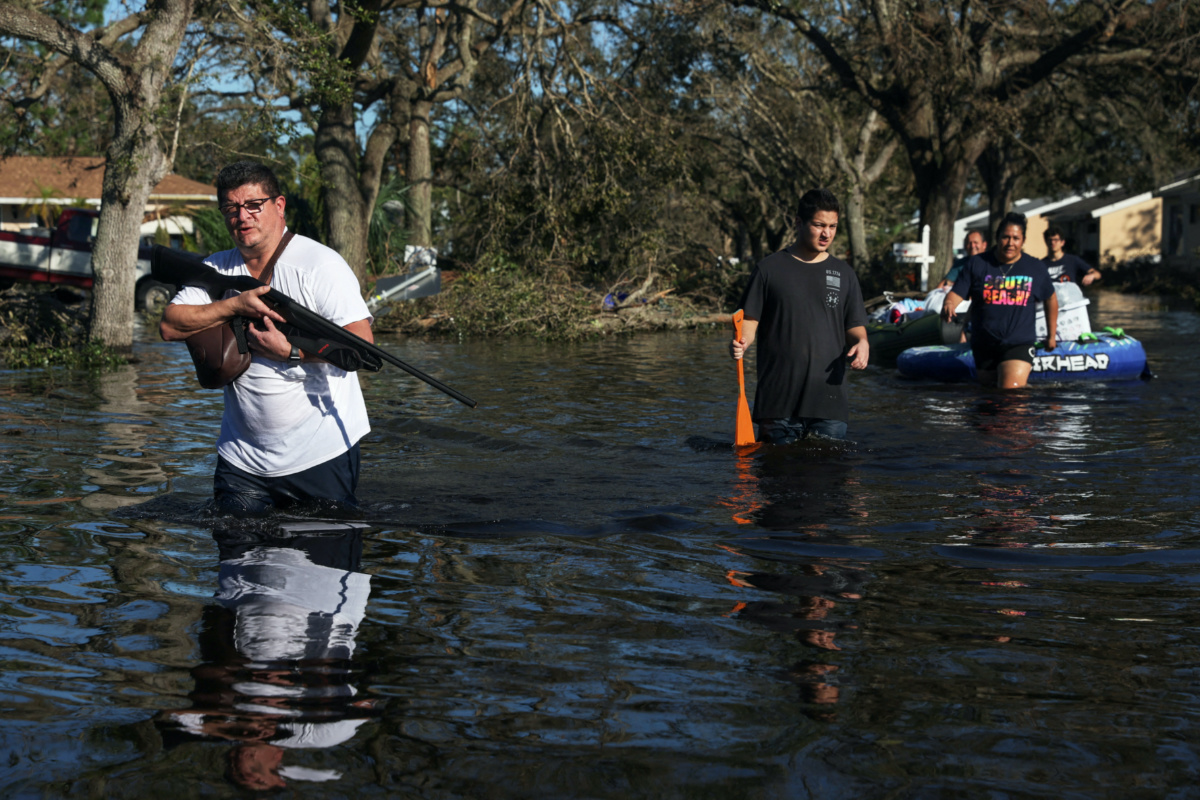Fort Myers, Florida/Charleston, South Carolina, US
Reuters
Florida and the Carolinas, staggered by one of the fiercest storms in US history, faced a massive recovery on Saturday as remnants of Hurricane Ian threatened further flooding along the Eastern Seaboard while leaving tens of billions of dollars in damage in its wake.
The number of confirmed fatalities from Ian rose to at least 50, most in Lee County, Florida, which bore the brunt of the storm when it slammed ashore the state’s Gulf Coast on Wednesday as a Category 4 hurricane packing maximum sustained winds of 240kph.

Destroyed homes and businesses on Pine Island, Florida are seen from a US Army National Guard Blackhawk helicopter as US National Guard Bureau Chief General Daniel Hokanson tours the area by air after Hurricane Ian caused widespread destruction in Pine Island, Florida, US, on 1st October. PICTURE: Reuters/Kevin Fogarty
The death toll was expected to climb higher as floodwaters receded and search teams reached more areas initially cut off by the storm.
As of Friday, some 10,000 people were reported unaccounted for in Florida, according to the state’s emergency management director, who added that many of those were likely safe in shelters or otherwise unreachable because of power and phone outages.
As the full extent of devastation came into clearer focus three days after Ian made US landfall, officials said some of the heaviest damage appeared to have been inflicted by raging wind-driven ocean surf that rushed into seaside communities and washed buildings away.
New satellite images from the National Oceanic and Atmospheric Administration showed beach cottages and a motel building that lined the shores of Florida’s Sanibel Island had been demolished by Ian’s storm surge. Even though most homes were still standing, they appeared to have roof damage, the images showed.
After waning to a tropical storm by the end of its march across Florida to the Atlantic, Ian regained hurricane strength and pummeled coastal South Carolina on Friday, sweeping ashore near Georgetown, north of the historic port city of Charleston, with sustained winds reaching 140 kph.
Numerous roads were flooded and blocked by fallen trees while a number of piers were damaged in that area.
More flooding forecast
Weakening again as it churned north and inland, Ian had been downgraded to a post-tropical cyclone by Saturday afternoon. But remnants of the storm were still expected to bring treacherous conditions to parts of the central Appalachians and mid-Atlantic, according to the National Hurricane Center.
Flood watches were posted for southwestern Virginia and southern West Virginia on Saturday, even as “major to record” flooding was forecast to continue in central Florida. The hurricane center said lesser flooding was expected across parts of the Appalachians, mid-Atlantic and coastal Carolinas.
About 1.2 million homes and businesses were without power in Florida as of 1pm EDT on Saturday, with about 300,000 other outages scattered across the Carolinas and Virginia.
Florida accounted for the overwhelming majority of confirmed storm-related deaths, with 35 tallied by the Lee County sheriff’s office and 11 others reported by state officials in four neighbouring counties.

A man carrying a gun walks with a family on a flooded street after Hurricane Ian caused widespread destruction, in North Port, Florida, US, on 30th September. PICTURE: Reuters/Shannon Stapleton
North Carolina authorities said at least four more people had perished there.
South Carolina Governor Henry McMaster told reporters on Saturday no storm-related deaths had emerged in his state and that most electricity had been restored. However, he added: “We know we have much cleaning up and rebuilding to do.”
Damage from high water, unleashed by storm surge along the coast and torrential rains further inland, was extensive.
“We suffered more flood damage than wind damage,” Florida Governor Ron DeSantis said Saturday. “That is going to require a lot of flood claims being filed.”
Insurers braced for a hit of between $US28 billion and $US47 billion in claims, in what could be the costliest Florida storm since Hurricane Andrew in 1992, according to US property data and analytics company CoreLogic.
President Joe Biden has approved a disaster declaration for Florida, saying Ian was “likely to rank among the worst [storms]…in the nation’s history.” On Saturday, he declared an emergency in North Carolina.
We rely on our readers to fund Sight's work - become a financial supporter today!
For more information, head to our Subscriber's page.
“Devastating”
The Florida city of Fort Myers, close to where Ian first made landfall, absorbed a major blow, with numerous houses destroyed.
Offshore, the popular tourist destination of Sanibel Island was cut off when a causeway bridge was rendered impassable.
Ricky Anderson, 57, a cashier who moved to the island from Illinois in June, said he “lost everything in the hurricane,” also worried about his neighbors.
“Where are all those people supposed to go that have no home anymore?” Anderson said.
Robert Hartman, 81, who has lived in Fort Myers for 50 years, said he needed the government’s help in the cleanup and repairs that lie ahead.
“We have no power, no phone service, nothing. We would just like a little help to get my home back in shape because I have nowhere to go,” he added, his voice choking.
– Additional reporting by KANISHKA SINGH, SHARON BERNSTEIN, MAKINI BRICE, MARIA ALEJANDRA CADONA and JUBY BABU






